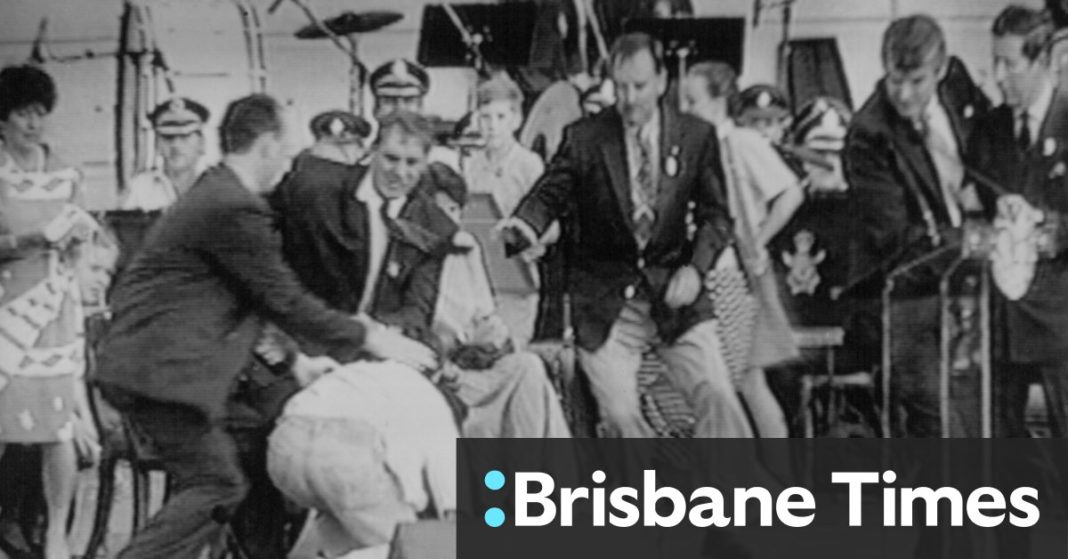King Charles has made 16 previous visits to Australia, and was shot at on one particularly memorable one. It hasn’t put him off.
Thankfully Charles was unharmed, but the dramatic event at an Australia Day ceremony in Sydney in 1994 is in keeping with the calamity and spectacle that generally accompanies royal tours to Australia, beginning with the very first one, made by Charles’ great-great-great uncle Prince Alfred in 1867.
Alfred, the second-eldest son of Queen Victoria, was an exciting celebrity to the people of the colonies, and something of a Victorian babe.
Charles (far right) is protected by his bodyguard after shots were fired from a starter pistol 1994.
Arriving on the Galatea for a six-month tour in October, he made footfall in Adelaide and formed a favourable view of the free-settler city.
“I have noticed in Adelaide an absence of the poor and rowdy class, so numerous elsewhere,” he wrote.
Alfred attracted huge crowds wherever he went, but an incident in Melbourne was a harbinger of the sectarian conflict and general chaos that marred his trip.
A Catholic mob formed outside the city’s Protestant hall, which was decorated with a large image of William of Orange (a huge provocation to Catholics). Shots were fired and a Catholic boy was killed. There was a riot.
A few days later, Alfred caused another riot, this time at a public banquet, when 30,000 more people than planned turned up “expecting free food and wine”.
They stormed the banquet tables and the fountains dispensing the celebratory booze – somewhat vindicating Alfred’s remark about the barbarism of the masses outside Adelaide.
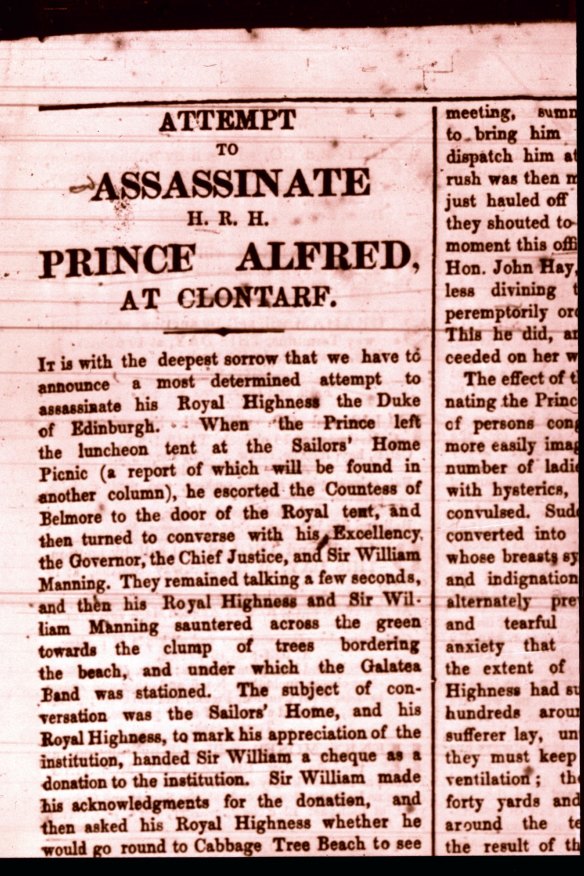
The 1868 assassination attempt against Prince Alfred , as recorded in The Sydney Morning Herald.Credit: Fairfax Archives
But it was Sydney that brought the real drama.
At a March 1868 picnic in the harbourside suburb of Clontarf, a man approached the prince and shot him from close range.
Alfred fell to the ground, shouting “Good God, I am shot … my back is broken!”
It wasn’t, but things didn’t end well for the would-be assassin, Henry James O’Farrell.
He was an Irish Catholic, and his attempt on the prince’s life provoked a fresh wave of anti-Catholic sentiment across the colonies.
O’Farrell appeared to be mentally unstable, and the prince asked that he be shown mercy. However, it was to no avail – O’Farrell was hanged at Darlinghurst Gaol on April 21, 1868.
Prince Alfred made a full recovery and set sail for England on April 4.

By the time Queen Elizabeth II arrived on our shores in 1954, we had learned to behave better.Credit: State Library of NSW
Australia would continue to provide both adoring crowds for visiting royals – sometimes in frightening numbers – as well as a scenic backdrop for family conflicts.
By the time Queen Elizabeth II arrived on our shores in 1954, we had learned to behave better.
The young Queen, who had assumed the throne just two years earlier, was greeted with the kind of rapture that is nowadays reserved for a Taylor Swift tour.
On February 4, the 27-year-old monarch alighted the royal yacht Gothic at Farm Cove – back where it all began for the colony 166 years previously.
Her husband, Prince Philip, travelled with her.
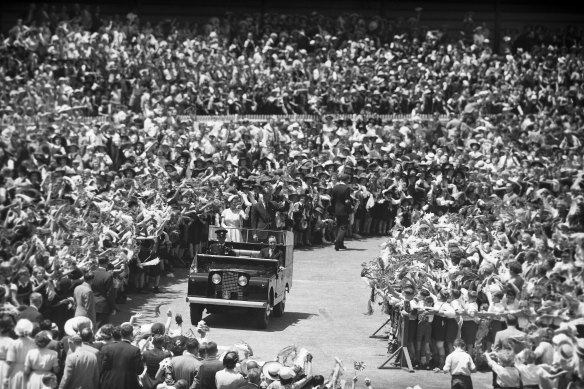
Queen Elizabeth and the Duke of Edinburgh at the SCG in 1954.Credit: Fairfax Media
The greeting party included prime minister Robert Menzies, governor-general Field Marshal Sir William Slim, and an estimated 1 million people, who lined the cove and nearby city streets (not bad for a city with an estimated population of 1.86 million).
Another half a million went to various vantage points around the harbour to glimpse the Queen, causing traffic jams that persisted well after midnight.
The weather was perfect, and the prose was purple.
“Sydney’s surging crowds received them with gay abandon,” reported The Sydney Morning Herald, which devoted its front page to every possible angle of the event, including one break-out story titled Wind’s Tricks with the Queen’s Hat.
“A puff of wind caught the Queen’s small white hat as she stepped from the barge but she quickly adjusted it and advanced to be received,” it reported.
Another story, written by “The Editress of Our Women’s Section”, was titled Every Woman’s Dream of Beauty Steps Ashore.
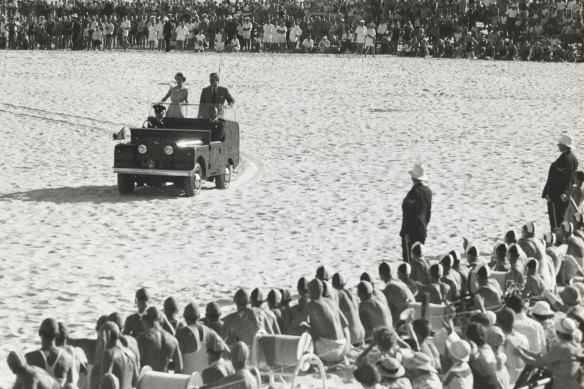
Queen Elizabeth and Prince Philip inspect lifesavers at Bondi Beach Surf Carnival in 1954.Credit: State Library of NSW
The Queen’s tour was a huge success. She drew enormous crowds and great public adoration.
Elizabeth’s itinerary was heroic – 56 days, with visits to every capital city except Darwin, and to 70 country towns.
Events were scheduled for morning, afternoon and evening, and included everything from watching a surf life-saving demonstration at Bondi Beach to opening a session of parliament.
Organisers were instructed to synchronise their watches with the ABC time signals at 9am every day.
But halfway through the tour, there was drama.
The royal couple had a weekend break at a chalet in the Yarra Ranges in Victoria. It was there that a media posse situated outside the chalet famously witnessed a raging argument between the newlyweds.
The rolling camera – there to capture the Queen with some local marsupials – instead filmed Prince Philip charging out of the chalet, followed by a pair of tennis shoes and a racquet, projectiles presumably thrown by his outraged wife.
The Queen followed him out the door and screamed at him. She then “dragged” him back inside.
Gentlemen of the press were a lot more gentlemanly back then.
On the request (or demand) of the Queen’s press secretary, the cameraman handed over his film and it was destroyed.
The Queen reportedly appeared some time later, unruffled, to fulfil her obligation.
“I’m sorry for that little interlude,” she said.
“But, as you know, it happens in every marriage. Now, what would you like me to do?”
The Queen went on to visit Australia another 15 times, although she gave us a wide berth for eight years between 1992 and 2000, thereby avoiding the embarrassment of the 1999 Republic referendum.
In 1983, her son Charles visited Australia with his new bride, Princess Diana.
It was during their Australian tour that cracks began to emerge in their doomed marriage.
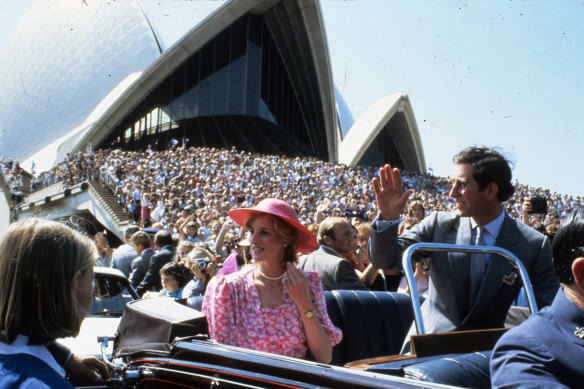
Charles and Diana arrive at Sydney Opera House in 1983.Credit: Getty Images
The public went wild for Diana, and Charles was reportedly jealous.
“[Charles] wasn’t used to that and nor was I,” Diana said years later.
“He took it out on me … I understood the jealousy but I couldn’t explain that I didn’t ask for it.”
There had been some trepidation from the palace before the tour.
The republican Bob Hawke was prime minister, and weeks before the royal couple’s arrival, he declared openly: “I don’t think we will be talking about kings of Australia forever more.”
Memories of the 1975 dismissal of Whitlam by governor-general Sir John Kerr were still fresh.
Courtiers, and reportedly the Queen herself, worried that the fragile young princess was not up to the gruelling tour, which had up to eight appearances built into a single day.
The 21-year-old new mother refused to leave her nine-month-old baby at home in England, so a delightfully plump Prince William accompanied them.
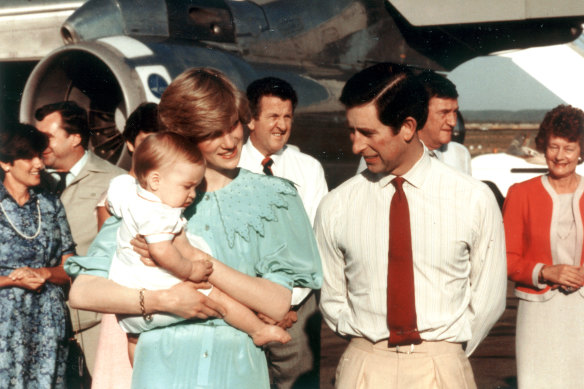
Princess Diana, Prince Charles and Prince William arrive in Alice Springs.Credit: Gerrit Fokkema
But Diana was forced to deposit him with nannies for days at a time while she fulfilled engagements, a separation she said was “like torture”.
During an event in Canberra, Diana met an army wife and told her: “I wish I didn’t have to leave William with his nanny. I’d much rather be doing what you are doing.”
The princess was overwhelmed by the heat and the crowds.
On arrival in Alice Springs, she got sunburnt and seemed faint when she walked around Uluru (actually she was just struggling with her skirt, which kept flying up in the wind).
A famous (and tragic) photograph of Diana shows her weeping in distress as she is surged by crowds outside the Opera House.
Her biographer, Andrew Morton, said the tour was “utterly traumatic” for the princess, and behind closed doors she “cried her eyes out, unable to handle the constant attention”.
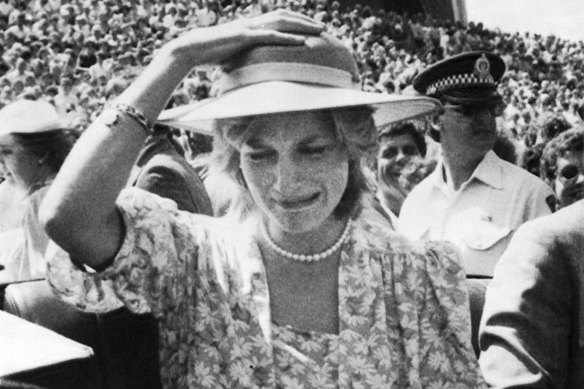
Biographer Andrew Morton said the tour was “utterly traumatic” for the princess.Credit: Alamy Stock Photo
Inwardly, she struggled, but outwardly, she delighted. Australians adored her.
And there were highlights – the couple danced together beautifully at the Wentworth Hotel in Sydney, Diana in a spectacular turquoise dress.
In Perth, Prince Charles tenderly kissed his wife’s hand.
The Times reported that the month-long tour was “an unqualified success, due in large part to the princess. She won the heart of Australia”.
Over 30 years later, in 2014, William visited Australia as an adult prince, with his new wife Catherine, whose popularity rivalled Diana’s.
They also brought their baby, Diana’s grandson Prince George, who spent most of the stay with his nanny in Canberra, although he made an appearance at Taronga Zoo, where he met a bilby. The royal couple visited Uluru and played DJ at some decks at a community youth centre in Adelaide. They fondled a koala and admired a fighter jet.
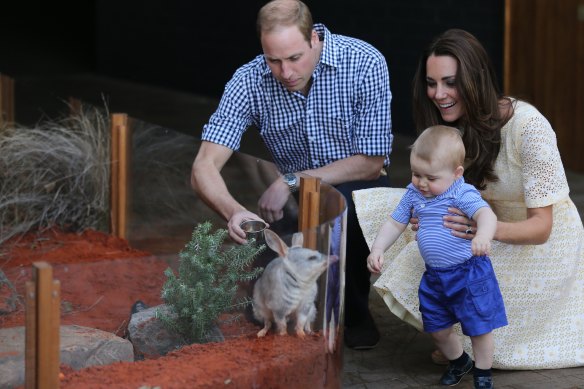
Prince William, Princess Catherine and Prince George meet a bilby at Taronga Zoo. Credit: Fairfax Media
“We go away with wonderful memories, and George goes away with his cuddly wombat, which he has taken to chewing so lovingly,” Prince William said.
In 2018, William’s now-estranged brother, Prince Harry, also visited with his new wife, Meghan. It was pre-Megxit, and she was widely adored.
The couple’s itinerary included Sydney, Dubbo, Melbourne and K’gari (formerly Fraser Island).
They used the trip to announce Meghan’s first pregnancy.
Crowds went wild for the pair, especially Meghan, who caused a particular public stir when she did a crowd walk around Sydney Opera House, just as her late mother-in-law had done (without the tears).
But the Australia tour was precursor to the moment when things began to “turn” for Harry and Meghan, according to the Duchess of Sussex in the couple’s tell-all Oprah Winfrey interview.
“After we had gotten back from our Australia tour … things really started to turn, when I knew we weren’t being protected,” Meghan said.
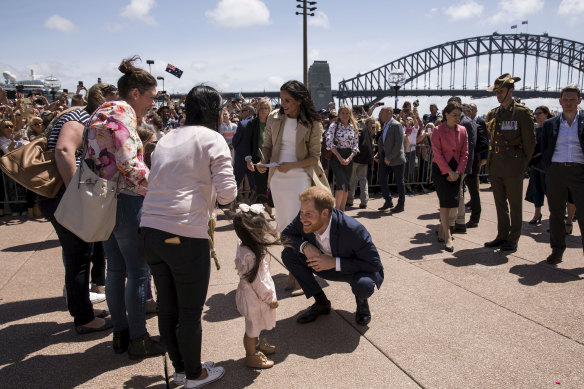
The Duke and Duchess of Sussex meet the crowd outside the Opera House in Sydney in 2018. Credit: Dominic Lorrimer
According to some journalists, the palace resented the duchess’ popularity.
Prince Harry said things “really changed after the Australia tour”.
“That was our first tour. It was also the first time that the family got to see how incredible she is at the job. And that brought back memories.”
Less than 18 months later, the pair quit the royal family.
They haven’t visited Australia since, but the two things are thought to be unrelated.
King Charles and Queen Camilla be warned – when on tour, unpredictability can never be planned for.
Perhaps we should not wish the royal couple a memorable visit.
Cut through the noise of federal politics with news, views and expert analysis. Subscribers can sign up to our weekly Inside Politics newsletter.


